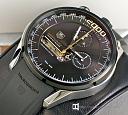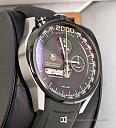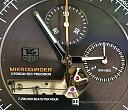Concept watches- like concept cars- can take one of two forms: either an outlandish styling exercise to win a few headlines, or a genuine preview of where a brand is headed. The TAG Heuer Mikrogirder, announced last week in Geneva, is definitely the latter. In fact, perhaps the least interesting part of the Mikrogirder story is the headline number of 5/ 10,000ths of a second. It’s easy to be blase about such a stunning achievement, but if TAG Heuer had simply reached this milestone by developing a faster evolution of the Mikrotimer (1/ 1,000ths second), then the story would not be as significant.
No, the real story of the Mikrogirder is the development of a new system for regulating mechanical watches and the beginnings of a push to change the way that Swiss watches are certified.
To get the inside word on the Mikrogirder, Calibre 11 spoke with TAG Heuer CEO Jean-Christophe Babin, technical guru Guy Semon (Vice President of Sciences and Engineering at TAG Heuer) and lead designer Christoph Behling. The Mikrogirder is the third ultra-high frequency watch in 12 months and is certainly the most interesting.
The Limit of Huygens
With that context, let’s take a look at the Mikrogirder Concept.
Every mechanical watch on sale today follows the principles established by Christiaan Huygens, who is credited with developing the regulating mechanism for watches around 1660- the hairspring and the balance wheel. Energy is sent to the balance wheel which rotates in one direction, only to be brought back to its original position by the hairspring- it’s these oscillations that control the time-keeping ability of a watch and can be measured in terms of beats per hour, or in hertz.
The math is quite simple- if you want to accurately measure 1/ 100th of a second, then you need the watch to beat 100 times every second, which is equivalent to 6,000 beats per minute or 360,000 beats per hour. How do you get a watch to beat faster? Guy Semon explains:
“If you take a standard hairspring on a standard 4hz watch, the hairspring is very large. To increase the frequency, you need to cut the spring to increase the rigidity”
Jean-Christophe Babin adds: “To get more speed you lessen the angle of oscillation, the but at some point there is no longer any rotation- the movement locks”.
And this makes sense, even if you aren’t technically minded. Imagine two toy Slinky springs at the top of a staircase. The Slinky that is 40 cm tall will travel more slowly down the stairs than one that is 20cm tall…but a Slinky too small won’t go anywhere.
And in the context of watches, the point at which the Huygens system is no longer effective is around 600-700 hertz (recall that the Mikrotimer is 500 hertz). TAG Heuer have pushed the Mikrotimer to this speed, but found it unworkable, meaning that if the company wanted to move past the benchmark set by the Mikrotimer, it would need to think of a new way of regulating time.
Mikrogirder- a New Approach
The Mikrogirder movement is based on the in-house TAG Heuer Mikrograph movement, which you see below. The magic of this movement is the dual-chain approach: a separate escapement for the watch (top right, 28,800 beats per hour) and the chronograph (bottom right, 360,000 beats per hour).
The Mikrogirder movement still uses a dual-chain approach- but instead of two traditional escapements as per the Mikrograph and Mikrotimer, you only see one, which is used for time-keeping (28,800 bph). Instead of a balance wheel and hairsrping, the regulation of the chronograph is achieved via three micro-beams, or girders. You can see the three beams in the window below.
Jean-Christophe Babin explained the concept with the help of the model below:
“So the new system is based on beams…micro-beams. We still have the escapement wheel [below in red], but instead of 20 teeth, we have about 40 teeth and an anchor [the open-mouthed "C" in white below], which is not a traditional anchor, but is linked the Excitatory beam [White]. There are three beams: the Excitatory beam; the Coupling beam [black]; and the Oscillating beam” [Blue].
Adds Semon:
“The anchor has a very specific geometry without pallets, and is manufactured as a beam. If you accelerate the anchor wheel you transform the kinetic energy of the anchor wheel into potential energy in the beam. Now you need an oscillator- one that’s very accurate. It’s a small beam that is calculated to have the first harmonic (the lowest frequency) at 1000hz. To reach this harmonic you need to transmit a level of energy to reach the harmonic. There’s a small contact point between the anchor beam and the oscillating beam [the coupling beam].”
So, to summarise, the three beams have the following roles:
- Excitatory beam: generates energy by transforming kinetic energy into potential energy
- Coupling beam: transforms the potential energy to the oscillator
- Oscillating beam: generates the right frequency
The Oscillating beam vibrates at an angle of only 5 degrees, allowing it to move very fast. The Mikrotimer oscillates at 28 degrees, while most watches oscillate at over 300 degrees.
The benefit of this approach is that it allows a frequency of greater than 600-700 hertz to be generated- in the case of the Mikrogider Concept, the movement produces 1,000 hertz, meaning 7.2 million beats per hour and accuracy to 5/ 10,000ths of a second, or 1/ 2,000th.
The other benefit is reduced wear and power consumption, as Jean-Christophe Babin explains:
The Mikrogirder consumes about half the energy of a traditional regulator at the same frequency- so, at 500hz the power reserve instead of being 4 minutes is 8 minutes. This is because you have fewer parts in motion, and about 20% fewer components, so there is less wear and less use of energy”.
Savremena stoperica bacili su se na jako precizno merenje vremena
Preuzite i jos informacija : TAG Heuer Mikrogirder: The Inside Story | Calibre 11 -TAG Heuer Watches
 Registracija
Registracija Help
Help


 7Likes
7Likes LinkBack URL
LinkBack URL About LinkBacks
About LinkBacks











 Odgovor sa citatom
Odgovor sa citatom odusevljen sam
odusevljen sam 
Bookmarks sajtovi